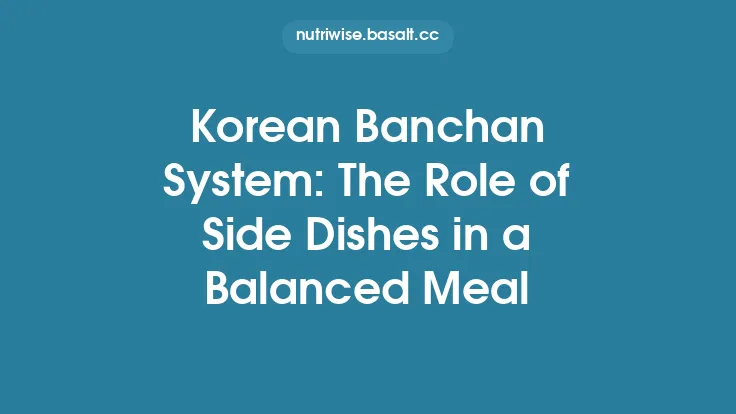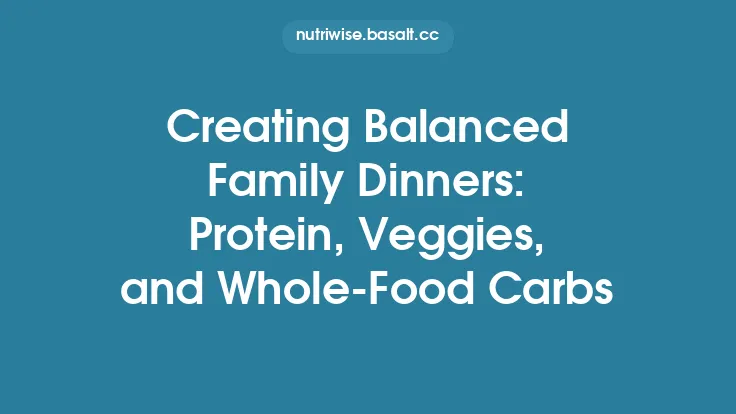Beans are a staple in many culinary traditions, prized for their affordability, protein content, and the comforting heartiness they bring to a meal. When prepared thoughtfully, they can also be a powerful ally for anyone looking to keep blood‑sugar levels steady throughout the day. The slow‑cooker—often called a crock‑pot—offers a unique set of conditions that, when paired with the right bean varieties and complementary ingredients, can produce dishes whose carbohydrate release is gradual and predictable. This article explores the science behind that process, outlines practical preparation steps, and provides a framework for creating balanced, blood‑sugar‑friendly bean meals that can be made in advance and enjoyed week after week.
Understanding Carbohydrate Release in Beans
Starch Structure and Digestibility
Beans store most of their carbohydrate energy as starch, a polymer of glucose units arranged in two distinct forms: amylose (linear chains) and amylopectin (branched chains). Amylose is digested more slowly because its linear configuration resists rapid enzymatic breakdown, while amylopectin is more readily hydrolyzed, leading to quicker glucose spikes. The amylose‑to‑amylopectin ratio varies among bean species; for example, black beans and kidney beans have relatively higher amylose content compared with navy beans, which are richer in amylopectin.
Resistant Starch Formation
When beans are cooked and then cooled, a portion of the starch retrogrades, forming what is known as resistant starch type 3 (RS3). RS3 is not digested in the small intestine; instead, it reaches the colon where it is fermented by the microbiota, producing short‑chain fatty acids that improve insulin sensitivity. Slow‑cooking followed by a cooling step maximizes RS3 formation, thereby blunting post‑prandial glucose excursions.
Glycemic Index (GI) vs. Glycemic Load (GL)
The GI measures how quickly a carbohydrate‑containing food raises blood glucose relative to pure glucose. However, GI alone does not account for portion size. Glycemic load (GL) incorporates both the GI and the amount of carbohydrate in a typical serving, offering a more realistic picture of a food’s impact on blood sugar. By controlling both the type of bean (lower GI) and the serving size (moderate GL), slow‑cooker dishes can be tailored for optimal glucose control.
Choosing the Right Beans for a Low Glycemic Impact
| Bean Variety | Approx. GI* | Amylose % | Typical Serving (½ cup cooked) | Fiber (g) |
|---|---|---|---|---|
| Black beans | 30–35 | 30–35 | 115 g | 7.5 |
| Adzuki beans | 30–35 | 28–32 | 115 g | 7.0 |
| Lentils (green) | 21–25 | 25–30 | 100 g | 8.0 |
| Chickpeas | 28–32 | 20–25 | 120 g | 6.0 |
| Navy beans | 40–45 | 15–20 | 115 g | 9.0 |
\*GI values are averages from multiple studies; individual responses may vary.
Beans with higher amylose content and lower overall GI—such as black beans, adzuki beans, and green lentils—are preferable for blood‑sugar‑friendly cooking. When planning a slow‑cooker recipe, aim for a base of one or two of these varieties, and consider mixing them to achieve a balanced texture and flavor profile.
Pre‑Cooking Preparations: Soaking, Rinsing, and Sprouting
- Soaking
- Purpose: Reduces antinutrients (phytic acid, oligosaccharides) that can cause gastrointestinal discomfort and improves water absorption, leading to more uniform cooking.
- Method: Place beans in a large bowl, cover with 3–4 × their volume of cool water, and let sit for 8–12 hours. For a quicker method, use the “hot‑soak” technique: bring beans and water to a boil, remove from heat, and let stand for 1 hour.
- Effect on Glycemic Response: Soaking leaches out some soluble sugars that would otherwise be rapidly digested, modestly lowering the GI.
- Rinsing
- After soaking, discard the soaking water (which contains leached sugars and antinutrients) and rinse beans thoroughly under running water. This step further reduces the potential for rapid glucose release.
- Optional Sprouting
- Sprouting beans for 24–48 hours after soaking can increase the proportion of resistant starch and boost the content of micronutrients such as vitamin C and B‑vitamins. If you choose to sprout, keep the beans in a breathable container, rinsing twice daily, and stop once the sprouts reach 1–2 cm in length. Sprouted beans cook faster, so adjust the slow‑cooker time accordingly (typically 2–3 hours less).
Slow‑Cooking Principles that Modulate Starch Digestion
Temperature Profile
- Slow‑cookers operate at low, steady temperatures (≈ 85–95 °C on the “low” setting, 95–105 °C on “high”). This gentle heat allows starch granules to gelatinize gradually, preventing the sudden rupture that can release large amounts of readily digestible glucose.
Cooking Time and Starch Retrogradation
- A typical “low” cycle of 6–8 hours or a “high” cycle of 3–4 hours is sufficient to fully soften most beans. Extending the cooking time beyond this window does not significantly increase digestibility; instead, it encourages the formation of RS3 during the cooling phase.
- Practical tip: After the cooking cycle ends, let the pot sit (with the lid on) for an additional 30 minutes. This residual heat promotes further retrogradation without additional energy input.
Moisture Management
- Maintain a liquid‑to‑bean ratio of roughly 3:1 (by volume). Too much liquid can leach soluble starches into the broth, raising its glycemic load, while too little can cause uneven cooking and a higher proportion of unsoftened starch.
- Adding a small amount of healthy fat (e.g., 1 tbsp olive oil) can coat starch granules, slowing enzymatic access and further flattening the glucose curve.
Avoiding Over‑Cooking
- Over‑cooked beans become mushy, releasing more free glucose into the cooking liquid. Aim for a texture where the bean holds its shape but yields easily to a fork. This balance preserves the structural integrity of the starch‑protein matrix, which is key to slower carbohydrate absorption.
Balancing Macronutrients: Adding Protein, Healthy Fats, and Fiber
A well‑rounded slow‑cooker bean dish should not rely on beans alone for macronutrient balance. Incorporating complementary foods can lower the overall glycemic load and improve satiety.
| Component | Recommended Amount per 4‑serving Batch | Rationale |
|---|---|---|
| Lean Protein (e.g., skinless chicken breast, turkey, tofu) | 200–250 g (≈ ½ lb) | Protein stimulates insulin secretion in a controlled manner and slows gastric emptying. |
| Healthy Fat (e.g., extra‑virgin olive oil, avocado oil, nuts) | 1–2 tbsp | Fat forms a physical barrier around starch granules, reducing the rate of glucose diffusion. |
| Non‑Starchy Vegetables (e.g., kale, bell peppers, zucchini) | 2–3 cups, chopped | Adds soluble and insoluble fiber, which further blunts post‑prandial spikes. |
| Whole‑Grain Add‑In (optional, for texture) | ¼ cup cooked quinoa or barley | Provides additional resistant starch and a modest amount of complex carbs, but keep portions small to avoid raising GL. |
When adding protein or fat, place them in the slow‑cooker at the beginning of the cooking cycle. This ensures they meld with the beans, allowing flavors to develop while also participating in the starch‑modulating effects of the cooking process.
Flavor Development without Raising Glycemic Load
Herbs and Spices
- Use aromatic herbs (bay leaf, thyme, rosemary) and spices (cumin, smoked paprika, coriander) liberally. They add depth without contributing carbohydrates.
- Fresh herbs such as cilantro or parsley should be added in the final 15 minutes to preserve their bright flavor.
Umami Boosters
- Low‑sodium vegetable broth, miso paste (use sparingly due to sodium), or a splash of tamari can enhance savory notes.
- A modest amount of grated Parmesan or nutritional yeast adds richness while contributing minimal carbs.
Acidic Elements
- A squeeze of lemon or lime juice added after cooking brightens the dish and can modestly lower the GI by slowing gastric emptying. Avoid adding acidic marinades during the cooking phase, as prolonged exposure can break down bean cell walls and increase starch release.
Sweeteners
- If a hint of sweetness is desired, opt for natural, low‑glycemic options such as a teaspoon of pure stevia or a small amount of monk fruit extract. Avoid honey, maple syrup, or regular sugar, which would raise the GL.
Practical Recipes and Variations
1. Slow‑Cooker Black‑Bean & Turkey Chili
- Ingredients: 1 cup dried black beans (soaked), 300 g ground turkey, 1 large onion (diced), 2 cloves garlic (minced), 1 red bell pepper (chopped), 1 tsp cumin, 1 tsp smoked paprika, 1 bay leaf, 3 cups low‑sodium vegetable broth, 1 tbsp olive oil, salt & pepper to taste.
- Method: Sauté onion, garlic, and turkey in a skillet with olive oil until lightly browned (optional step for flavor). Transfer to slow‑cooker, add soaked beans, vegetables, spices, broth, and bay leaf. Cook on low 7 hours. Remove bay leaf, stir, and let sit 30 minutes before serving. Portion into four servings; each provides ~30 g carbohydrate, 12 g fiber, and a GL of ~9.
2. Lentil‑Kale Stew with Coconut Milk
- Ingredients: 1 cup green lentils (soaked 4 h), 2 cups chopped kale, 1 cup diced carrots, 1 cup diced celery, 1 tsp turmeric, 1 tsp ginger (ground), 1 tbsp coconut oil, 3 cups unsweetened coconut milk, 2 cups water, 1 tbsp lime juice, salt to taste.
- Method: Combine all ingredients in the slow‑cooker, stir, and cook on low 6 hours. Add lime juice just before serving. This dish offers a creamy texture with a modest GL due to the high fiber content of lentils and kale.
3. Mediterranean Chickpea & Quinoa Bake (Low‑GI Version)
- Ingredients: 1 cup chickpeas (soaked), ½ cup quinoa (rinsed), 1 cup diced tomatoes (no‑salt), ½ cup diced zucchini, 1 tsp oregano, 1 tbsp olive oil, 2 cups low‑sodium chicken broth, ¼ cup feta crumbles (optional).
- Method: Layer ingredients in the slow‑cooker, pour broth over, and cook on low 5 hours. Sprinkle feta 15 minutes before the end of cooking. The quinoa portion is kept small to limit additional carbs while adding a pleasant texture.
Customization Tips
- Swap Proteins: Replace turkey with tempeh for a plant‑based version; adjust cooking time (tempeh needs only 2 hours on low).
- Seasonal Veggies: Incorporate winter squash, cauliflower, or Brussels sprouts for variety; these add bulk and fiber without raising GI.
- Batch Size: Scale recipes up or down, but keep the bean‑to‑liquid ratio consistent to avoid overly thick or watery results.
Portion Management and Blood Sugar Monitoring
Even the most carefully crafted bean dish can cause a glucose rise if portion sizes are excessive. Here are evidence‑based guidelines:
- Measure Carbohydrate Content
- A standard cooked bean serving (½ cup) contains roughly 15–20 g of total carbohydrate, of which 6–9 g are fiber. Net carbs (total minus fiber) therefore range from 6–11 g.
- Calculate Glycemic Load (GL)
- GL = (GI × net carbs ÷ 100).
- Example: Black beans (GI ≈ 35) with 8 g net carbs → GL ≈ 2.8, which is considered low.
- Use the Plate Method
- Fill half the plate with non‑starchy vegetables, one‑quarter with beans (or bean‑based dish), and one‑quarter with lean protein or a modest amount of whole grain. This visual cue helps keep carbohydrate portions in check.
- Post‑Meal Glucose Checks
- For individuals monitoring blood glucose, test 30 minutes and 2 hours after the meal. A rise of < 30 mg/dL (1.7 mmol/L) from baseline is generally indicative of a well‑controlled glycemic response.
- Adjust Based on Personal Response
- If post‑meal glucose consistently exceeds target ranges, consider reducing the bean portion by ¼ cup or adding extra fiber (e.g., a side salad with chia seeds) to further slow absorption.
Storage, Reheating, and Food Safety
Cooling and Refrigeration
- After the optional 30‑minute resting period, transfer the bean dish to shallow containers and refrigerate within two hours of cooking. Rapid cooling preserves RS3 and minimizes bacterial growth.
Shelf Life
- Properly stored, slow‑cooker bean dishes last 4–5 days in the refrigerator. For longer storage, freeze in airtight containers for up to three months. Thaw overnight in the refrigerator before reheating.
Reheating
- Reheat on the stovetop over low heat or in a microwave at 50 % power, stirring occasionally. Avoid boiling the dish again, as high temperatures can degrade resistant starch.
Safety Note
- Beans contain lectins that are inactivated only after thorough cooking (≥ 70 °C for at least 10 minutes). Ensure the slow‑cooker reaches and maintains this temperature throughout the cooking cycle; most modern models do, but older units may require a “high” setting for the first hour.
Integrating Slow‑Cooker Bean Dishes into a Blood‑Sugar‑Friendly Meal Plan
- Meal Prep Rhythm
- Cook a large batch of beans on the weekend (e.g., 2 kg of mixed beans). Portion into individual containers with complementary proteins and vegetables for quick weekday lunches or dinners.
- Strategic Pairings
- Pair bean dishes with low‑GI sides such as leafy greens, roasted cauliflower, or a small serving of quinoa. Avoid high‑GI accompaniments like white rice, mashed potatoes, or sugary sauces.
- Snack Options
- Use leftover beans as a base for a high‑protein snack: mix with Greek yogurt, a dash of cumin, and chopped cucumber for a dip, or blend into a smoothie with unsweetened almond milk and a handful of spinach.
- Mindful Eating Practices
- Eat slowly, chew thoroughly, and pause between bites. The act of mindful eating itself can reduce the rate of glucose absorption by allowing the body’s hormonal signals to regulate digestion more effectively.
- Periodic Review
- Every few weeks, reassess portion sizes and ingredient choices based on blood‑glucose logs, weight trends, and personal satiety cues. Small tweaks—like adding a tablespoon of ground flaxseed or swapping a portion of beans for edamame—can keep the diet both interesting and glycemically stable.
By leveraging the gentle, consistent heat of a slow‑cooker, selecting beans with favorable starch profiles, and thoughtfully balancing proteins, fats, and fiber, you can create meals that deliver sustained energy without the roller‑coaster spikes often associated with carbohydrate‑rich dishes. The result is a versatile, make‑ahead repertoire of bean‑centric plates that support long‑term blood‑sugar management while satisfying the palate and the schedule. Happy slow‑cooking!





